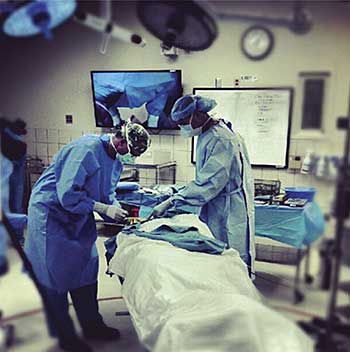At Seattle Hospital, Online Video Educates on Hearing Treatment
"We actually created a social media backpack, so they were able to take it up all the way with them, and we were able to stream from the mountain, to answer people's questions and to have a conversation about the fact that they were doing this with people who had been through organ donation, to show that because of the gift of an organ donation, people continue amazing lives, to raise awareness and just start that conversation," said Lewis. "We did that using a solar-powered backpack, and were able to stream out onto the web, and that was really cool."
While the cochlear implant series wasn't the most technologically advanced of the center's online projects, Lewis says it was a tremendous experience. "It was a really powerful thing, knowing that it was definitely targeted at our audience...people with hearing loss or their loved ones." These are people, Lewis points out, who are used to using pictures and text and closed captioning, versus traditional live stream technology. "I'm really proud that we were able to come up with a number of different ways to engage this audience, who traditionally may not participate in a live stream video, because of the difficulty in live transcribing or closed captioning something like that."
Moved by the Experience
According to Lewis, "After the live tweeted and Instagrammed surgery, we had a much broader audience than we expected, including a lot of international participants, and the question everybody had when we were done was, "What's next? Are you going to live stream Mrs. Day's activation?"
Actually, the biggest part of the hearing loss series almost didn't happen. It wasn't in the planning to show what happened with the patient whose surgery was broadcast live. But when viewers demanded to know how the story ended, a new chapter had to be added.
"We hadn't planned on it, but we talked to her and she was very excited to continue to share her story and to help educate people." So on a week's notice, the decision was made to also live stream Day's implant activation and then narrate it via text using a chat function for those who couldn't hear. As Lewis describes it, "You could still see what was going on, understand the process and you could definitely see the joy on her face when she was able to hear her husband for the first time" in years. This additional footage extended the web series a little bit. "We hadn't originally intended to live stream that part. But because of the request and the interest in it, we decided to do that as well."
 For the squeamish, the idea of live streaming or even live Instagramming a surgery sounds pretty unappealing. But the center didn't have qualms about putting such material online.
For the squeamish, the idea of live streaming or even live Instagramming a surgery sounds pretty unappealing. But the center didn't have qualms about putting such material online.
"People probably have different opinions on what is too graphic," Lewis said. "We do try to put out a tweet ahead of time that says, ‘Warning, some of these images may be graphic.' That's something we learned from our knee surgery. The video of the open knee, some people thought it was graphic, so we learned to be cautious and warn people. But even if we do warn people and say, hey, you know, the next couple of pictures may be kind of graphic, if just somebody happens across it, and are not following the stream, they still may miss the warning. So there's a possibility that people will see it.
Lewis adds, "You probably see all kinds of stuff online that could be considered graphic in other ways. It's the nature of the internet. Images of the cochlea, it's not too bad, in my opinion -- especially in an educational setting where a lot of people have had this procedure, are interested in having it again, or are trying to decide whether or not they want it. A lot of them say it's graphic, but they want to know what's happening to them, they want to see what it's like, or what it was like from the other side. We've gotten feedback that have said it's been very valuable for them."
The Swedish Medical Center has gotten a terrific response following the event, both on a large and small scale. The Atlantic mentioned it in a feature on the most interesting health stories of 2012, saying it demystified healthcare. The center has also heard from people sharing their personal experiences. One viewer in England tweeted to say that she had gotten a cochlear implant 10 years ago and was reluctant to get an improved device since the process had been so unpleasant. Seeing the advances in the procedure, however, made her decide to talk to her doctor about it.
"The great thing about technology is it's not one size fits all," Lewis notes. "There's a lot of amazing things that can be done with live streaming technology, and it's exciting to see healthcare organizations and other industries using it in new and different ways. I hope Swedish and other healthcare organizations continue to embrace it and use it to help people."
This article appears in the forthcoming 2013 Streaming Media Industry Sourcebook.
Related Articles
From training to remote observations, the use of streaming video in the medical and pharmaceutical markets is growing.
08 Oct 2019